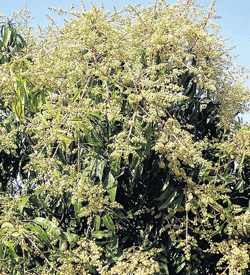Thick blossom promises a bumper mango crop
This year the farmers are expecting a bumper mango crop, despite the fact that this is an ''off year'' for mangoes, when the yield is generally low. Last year (2011) was ''on year'' for mangoes, while 2010 was an ''off year.''

The optimism of mango farmers stems from the fact that there is a thick blossom of mango flowers indicating a good crop.
In recent times due to climate variation, the mango season which begins with the blossoming in December has this time begun in January. The blossoming continues till end of February.
Dry spell prior, extended period of monsoon and moisture also extend blossoming further in the season.
Every season, mangoes arrive in the market either in the last week of April or the first week of May. However, this time mangoes are likely to arrive only by the end of May or first week of June.
According to the Assistant Director of Horticulture, despite being an “off year” for mangoes, a bumper crop is expected this time going by the thick blossoming of the mango flowers. Under the present circumstances even if the blossoms wither, it will not affect the mango crop yield, he added.
According to scientific analysis of carbon to nitrogen ratio (CN ratio), a good crop is expected.
This time a few cases of ‘Cicadellidae’ (leaf hopper) and the ‘Boodiroga’ diseases have been noticed. However, if this is controlled, then the withering of blossoms will be less.
The extent of mango cultivation in the district has increased. In 2010 mango was grown in 40,769 hectares. Last year it was cultivated in 43,177 hectares, an increase of 2,408 hectares. This year the extent of cultivation remains the same.
Of the total area under mango cultivation in the State (1,17,381 hectares) as much as 47 per cent is in Kolar district, which is known as the mango bowl. The extent of mango grown in Kolar includes Srinivaspur (22,325 hectares), Mulbagal (11,670 hectares), Bangarpet (3,461 hectares), Kolar (4,294 hectares) and Malur (1,427 hectare).
In the “on year” in 2009 as much as 4,64,115 tonnes of mangoes were produced. Last year, the yield was 5,17,404 tonnes at the rate of 12 tonnes per hectare.
Deccan Herald is on WhatsApp Channels| Join now for Breaking News & Editor's Picks